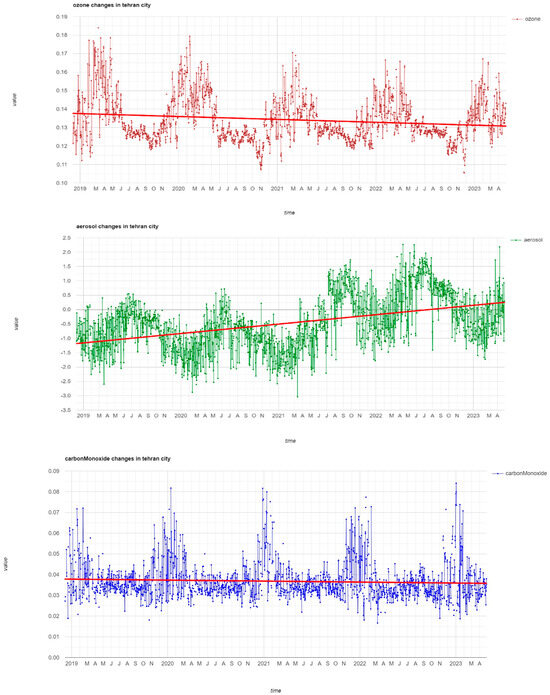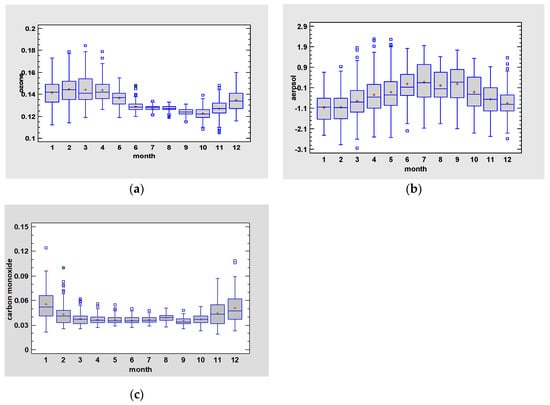Abstract
In recent years, by expanding cities, air pollution has become one of the most important problems caused by humans. Tehran, as the capital of Iran, is expanding gradually and its population is rising day by day. Therefore, the increase in human activities causes many problems, such as air pollution, in this area. In this study, data from Sentinel-5 for Tehran city are used from the last month of 2018 to present and collected from the Google Earth Engine. Three main parameters of air pollution are studied, including aerosol, ozone and CO. Different statistics of each parameter are calculated. Then, temporal evolutions are analyzed using Statgraphics. From the analysis, the calculated aerosol median is −0.555 mol and the interquartile range is 1.248 mol . For the ozone parameter, the median is calculated to be 0.131 mol and the interquartile range is 0.015 mol . Also, for the CO parameter, the median is 0.037 mol and the interquartile range is 0.011 mol . The total trend of aerosol is increasing, especially during the summer months, when aerosol amounts are higher than in the winter months. Our statistics show a decreasing trend for the ozone parameter, but in the winter months, ozone is higher than in the summer months. The trends for aerosol and ozone are statistically significant at the 95% confidence level. The trend of CO is totally stable but a little higher at the end of fall and during the first days of winter.
1. Introduction
Among the developing countries, changing climate and weather situations and the growing rate of pollution parameters in air have become two core worries around the world. Climate change has a substantial influence on air pollution by affecting meteorological conditions. And air pollutants can influence variations in the climate structure by affecting atmospheric radiation and cloud formation [1]. The population of Tehran has grown about 2.5-fold and urban areas have enlarged 8.5-fold during last few years [2]. Rapid urbanization has been associated with the emergence of industrial units, electricity production and refineries in Tehran during this era. These influences, accompanied by a topographical state of affairs that affects air pressure, temperature and the inversion phenomenon, have led to an increase in the concentration of air pollutants in Tehran and cardiovascular and respiratory deaths [3,4].
Adverse health effects linked with various air pollutants accentuate the inevitability of the need for trend revisions. For example, CO can enter the body through the lungs, and has the potential to reduce the oxygen-carrying capacity of the blood, thereby affecting the circulatory system and the delivery of oxygen to organs and tissues [5].
Aerosols play an essential role in atmospheric processes because they are colloids of liquid or solid particles suspended in the air [6,7]. Aerosols represent several particles that affect air quality, climate, human health and the hydrological cycle through various mechanisms [7,8]. The incoming and outgoing solar radiation and interruption of the radiative heating and cooling of the Earth’s surface are affected by aerosols, meaning they change the energy balance [9].
Ozone is one of the most important photochemical oxidants that applies adverse effects on human health, in conjunction with ecological damage inflicted on agronomic crops and products at a significant level [10,11]. Though numerous ozone abatement plans that have been developed, the investigation of its properties is thus far ongoing due to the presence of various causes such as forerunner releases, nonlinear associations between ozone and its forerunners, and the effects of meteorological and climatological features on ozone buildup and conveyance [12].
2. Methods
TROPOMI is subsidized by the Netherlands Space Office and the European Space Agency (ESA) cooperatively; it is the only cargo on the Sentinel-5p spacecraft and was launched on 13th October 2017 into the low Earth orbit. The data and wavelength bands between ultraviolet and shortwave infrared are obtained by a space-borne spectrometer. O3, NO2, SO2, bromate (BrO3−), formaldehyde (HCHO) and water vapor (H2O); tropospheric columns from the ultraviolet, visible and near-infrared wavelengths; and CO and methane (CH4) tropospheric columns are measured from the short-wave infrared wavelength range by TROPOMI via spectral bands from the visible, near-infrared and ultraviolet wavelength range [13].
The third largest metropolis in the Middle East region is Tehran, which is the key urban center of Iran, so it has more than 8.8 million inhabitants [14]. Tehran is situated in a valley with an altitude of 1000 to 1800 m above sea level, and it is surrounded from north to northeast by mountains; in addition, it is located between 35°34′ N to 35°59′ N latitude and 51°5′ E to 51°53′ E longitude [15]. Year by year, air pollution intensifies for different reasons, such as the growing population rate, the geographical circumstances of Tehran, the use of transportation and industrial actions [16,17].
In this study, all data were collected from the Google Earth Engine, and then, the data were analyzed using Statgraphics and are presented as graphs, charts and tables in next chapter. Data of the three main parameters of air pollution were collected from the end of 2018 up to the first months of 2023 in the area of Tehran city.
3. Results and Discussion
It was predicted that the mentioned parameters have changed during these four years. In the following in Figure 1, these changes are clear. In the first chart, ozone decreases year by year, and the amount of it in the fall months is less. Conversely, aerosol has an increasing trend and grows yearly, and the maximum amount is observed at the end of spring and in the first months of summer. Meanwhile, carbon monoxide has an approximately stable trend and does not have significant variation; actually, in some months, like December and January, it has the highest amount, but it has same amount in same months in the previous years.

Figure 1.
Charts of the three studied parameters, ozone, aerosol and carbon monoxide, respectively.
The red line indicates the trend of each parameter in Figure 1. This red line decreases smoothly in the ozone chart, increases in aerosol chart and is invariable in last chart.
Using Statgraphics, the data were evaluated, and box and whiskers plots for the months are plotted in Figure 2. Regarding the ozone parameter, it is possible to say that fewer changes correspond to the summer months, and the winter months are more varied. In plot (b), variation in aerosol is shown. As is shown in the other charts, this parameter changes a lot and, in the summer months, there are more variations in total in a year. In plot (c), carbon monoxide does not have many fluctuations except in the winter months.

Figure 2.
Box and whiskers plot for the three studied parameters, ozone, aerosol and carbon monoxide, respectively.
The data collected were also analyzed using some different statistical parameters, such as the average, median and other stats, all of which are mentioned in Table 1. The interquartile range was calculated for ozone (0.015 mol ), for carbon monoxide (0.011 mol ) and for aerosol (1.248 mol ).

Table 1.
Summary statistics for the three mentioned parameters in mol units.
4. Conclusions
The three main parameters of air pollution in Tehran city were studied, and the results show that aerosol has increased, ozone has decreased, and CO has a stable trend. These results can be used to detect polluted months during this period and to protect human life in the future. These parameters can be studied for other areas, especially industrial ones, to understand the most polluted areas and days of the year.
Author Contributions
Conceptualization, methodology, resources, formal analysis, investigation, F.P. and M.Á.G.; visualization, software, data curation, writing—original draft preparation, writing—review and editing, F.P.; writing—review and editing, S.R. and I.A.P.; validation, supervision, project administration, I.A.P. and M.Á.G. All authors have read and agreed to the published version of the manuscript.
Funding
This research received no external funding.
Institutional Review Board Statement
Not applicable.
Informed Consent Statement
Not applicable.
Data Availability Statement
Data may be obtained from https://earthengine.google.com/.
Conflicts of Interest
The authors declare no conflict of interest.
References
- Zhang, B.; Yin, S.; Lu, X.; Wang, S.; Xu, Y. Development of city-scale air pollutants and greenhouse gases emission inventory and mitigation strategies assessment: A case in Zhengzhou, Central China. Urban Clim. 2023, 48, 101419. [Google Scholar] [CrossRef]
- Sharifi, A.; Hossein gholizadeh, M. The effect of rapid population growth on urban expansion and destruction of green space in Tehran from 1972 to 2017. J. Indian Soc. Remote Sens. 2019, 47, 1063–1071. [Google Scholar] [CrossRef]
- Shahbazi, H.; Abolmaali, A.M.; Alizadeh, H.; Salavati, H.; Zokaei, H.; Zandavi, R.; Hosseini, V. An emission inventory update for Tehran: The difference between air pollution and greenhouse gas source contributions. Atmos. Res. 2022, 275, 106240. [Google Scholar] [CrossRef]
- Dehghan, A.; Khanjani, N.; Bahrampour, A.; Goudarzi, G.; Yunesian, M. Short-term effects of ambient (outdoor) air pollution on cardiovascular death in Tehran, Iran—A time series study. Toxin Rev. 2020, 39, 167–179. [Google Scholar] [CrossRef]
- World Health Organization (WHO). Air Quality Guidelines for Europe, 2nd ed.; WHO Regional Publications European Series No. 91; World Health Organization: Geneva, Switzerland, 2000. [Google Scholar]
- Eshet, A.; Raju, U.J.P. Daily and seasonal variation of aerosol optical depth and angstrom exponent over Ethiopia using MODIS data. Pollution 2022, 8, 315–329. [Google Scholar] [CrossRef]
- Nair, A.S.; Singh, P.; Soni, K.; Meena, K.; Sharma, R. Sway of aerosol on Atmospheric Boundary Layer influencing air pollution of Delhi. Urban Clim. 2023, 49, 101478. [Google Scholar] [CrossRef]
- Li, Z.; Guo, J.; Ding, A.; Liao, H.; Liu, J.; Sun, Y.; Wang, T.; Xue, H.; Zhang, H.; Zhu, B. Aerosol and boundary-layer interactions and impact on air quality. Natl. Sci. Rev. 2017, 4, 810–833. [Google Scholar] [CrossRef]
- Steiner, A.L.; Mermelstein, D.; Chengg, S.J.; Twine, T.E.; Oliphant, A. Observed impact of atmospheric aerosols on the surface energy budget. Earth Interact. 2013, 17, 1–22. [Google Scholar] [CrossRef]
- Harrou, F.; Kadri, F.; Khadraoui, S.; Sun, Y. Ozone measurements monitoring using data-based approach. Process Saf. Environ. Prot. 2016, 100, 220–231. [Google Scholar] [CrossRef]
- Wang, X.; Lu, W.; Wang, W.; Leung, A. A study of ozone variation trend within area of affecting human health in Hong Kong. Chemosphere 2003, 52, 1405–1410. [Google Scholar] [CrossRef] [PubMed]
- García, M.A.; Sánchez, M.L.; Pérez, I.A.; De Torre, B. Ground level ozone concentrations at a rural location in northern Spain. Sci. Total Environ. 2005, 348, 135–150. [Google Scholar] [CrossRef] [PubMed]
- Hashim, B.M.; Al-Naseri, S.K.; Al-Maliki, A.; Al-Ansari, N. Impact of COVID-19 lockdown on NO2, O3, PM2.5 and PM10 concentrations and assessing air quality changes in Baghdad, Iraq. Sci. Total Environ. 2021, 754, 141978. [Google Scholar] [CrossRef] [PubMed]
- Amini, H.; Taghavi-Shahri, S.M.; Henderson, S.B.; Hosseini, V.; Hassankhany, H.; Naderi, M.; Ahadi, S.; Schindler, C.; Künzli, N.; Yunesian, M. Annual and seasonal spatial models for nitrogen oxides in Tehran, Iran. Sci. Rep. 2016, 6, 32970. [Google Scholar] [CrossRef] [PubMed]
- Naddafi, K.; Hassanvand, M.S.; Yunesian, M.; Momeniha, F.; Nabizadeh, R.; Faridi, S.; Gholampour, A. Health impact assessment of air pollution in megacity of Tehran, Iran. Iran. J. Environ. Health Sci. Eng. 2012, 9, 28. [Google Scholar] [CrossRef] [PubMed]
- Sotoudeheian, S.; Arhami, M. Estimating ground-level PM 10 using satellite remote sensing and ground-based meteorological measurements over Tehran. J. Environ. Health Sci. Eng. 2014, 12, 122. [Google Scholar] [CrossRef] [PubMed]
- Kamali, N.; Zare Shahne, M.; Arhami, M. Implementing spectral decomposition of time series data in artificial neural networks to predict air pollutant concentrations. Environ. Eng. Sci. 2015, 32, 379–388. [Google Scholar] [CrossRef]
Disclaimer/Publisher’s Note: The statements, opinions and data contained in all publications are solely those of the individual author(s) and contributor(s) and not of MDPI and/or the editor(s). MDPI and/or the editor(s) disclaim responsibility for any injury to people or property resulting from any ideas, methods, instructions or products referred to in the content. |
© 2023 by the authors. Licensee MDPI, Basel, Switzerland. This article is an open access article distributed under the terms and conditions of the Creative Commons Attribution (CC BY) license (https://creativecommons.org/licenses/by/4.0/).